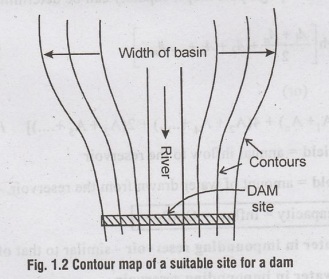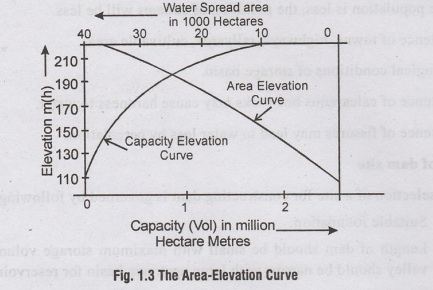Water Supply And Wastewater Engineering: Unit I: Water Supply
Estimation of Surface and Sub-Surface Water Resources
Natural large-sized depression formed on earth surface, when filled with water is called a pond or lake. Surface runoff from nearby catchment area drains water into lakes Sometimes, small springs also drain underground water into ponds and lakes.
ESTIMATION
OF SURFACE AND SUB-SURFACE WATER RESOURCES
1.
Natural Ponds and Lakes
2.
Streams and Rivers
3.
Impounding Reservoirs
1. Natural Ponds and
Lakes as surface sources of supplies
Natural
large-sized depression formed on earth surface, when filled with water is called
a pond or lake.
Surface
runoff from nearby catchment area drains water into lakes
Sometimes,
small springs also drain underground water into ponds and lakes.
Quality of water in Lakes:
•
Good quality
•
There is no need of much purification
•
Self purification of water occurs in lakes due to:
*
Sedimentation of suspended matter
*
Bleaching of colour
*
Removal of bacteria etc.
•
Larger and older lakes are more purer.
•
As lakes are still and standing waters, it contribute to growth of algae and
aweeds, imparting bad smell, taste, colour to waters.
Quantity of water
•
Small quantity of water
•
The quantity depends on - Catchment area
-
Annual rainfall
-
Geological formation
•
Lakes cannot be used as a principal source of water supply.
•
Lakes are useful for small towns and hilly areas only.
•
When no other sources are available, lakes may be used for water supply.
•
Example - Water supply to Bombay city is from lakes.
2. Streams and Rivers
as surface sources of supplies
(a) Streams
*
As the quantity of water is less, it is not suitable for water supply schemes.
*
They are useful for small villages and hilly areas.
*
However, large perennial streams may be used as sources of water by providing
storage reservoirs.
(b) River
*
Most important source of water for public water supply.
* Rivers may be perennial or non-perennial.
*
In perennial rivers, water is available throughout the year.
*
Perennial rivers can be used as a source for water supply.
Quantity -
Good source of water supply to cities mostly located nearby the rivers.
Quality -
Water quality is not reliable.
*
River water has large amount of silt, sand and suspended matter.
*
The disposal of sewage into river contaminates the waters.
*
Proper treatment is required for river waters before supply to public.
3. Storage reservoirs
/ Impounding reservoirs as surface sources of supplies
The
rivers or streams when directly used for water supply schemes fail due to the
following problems.
•
During low flows (dry season), it cannot meet the demand of the consumers.
•
During high flows, it leads to devastating floods. Hence, it is necessary to
build a barrier or dam or storage / impounding reservoirs at the upstream of
rivers to store the excess water (during high flows) and supply to public
(during low flows).
An Impounding Reservoir is an artificial lake created by connstruction of dam across a water course.
The
objective is to impound (store) water for water supply schemes.
Parts of an Impounding reservoir
(i) Dam to hold back water
(ii)
Spillway to discharge excess flow
(iii)
Gate valves to regulate water flow
Location of impounding reservoir is
selected based on the following factors
(i)
Existence of suitable dam site - short and narrow dams.
(ii)
Quantity of water available should be sufficient to meet the demand throughout
the year.
(Rainfall,
runoff, catchment area characteristics.)
(iii)
Distance and elevation of reservoir with reference to point of distribution.
Longer
distance - cost will be high
Higher
elevation – cost is low due to gravity flow. Pumping is not required
(iv) Density and distribution of population over the catchment area. If the population is less, the pollution of streams will be less.
(v)
Existence of towns, highways, railyards, cultivable areas.
(vi)
Geological conditions of storage basin.
Existence
of calcareous bed rocks may cause hardness to water.
Existence
of fissures may lead to water loss by percolation.
Selection of dam site
The
selection of a site for constructing dam is governed by following factors:
(i)
Suitable foundation.
(ii)
Length of dam should be small with maximum storage volume. The river valley
should be narrow with large upstream basin for reservoir.
(iii)
Bed level of dam site should be higher than river basin.
(iv)
Construction materials should be locally available.
(v)
Reservoir basin shuld be water tight
(vi)
Land value should be low
(vii)
Accessible and well connected by roads, rails to towns and cities.
(viii)
Labour easily available.

Storage capacity of reservoir
It
is determined from the Contour maps of the area (Topographic survey)

The
volume of water that can be stored by the reservoir at a certain water surface
elevation can be computed by summing up the increment between two elevations.

In
the absence of topographic maps, capacity can be determined using, formulae.

Catchment yield
= annual inflow to the reservoir
Reservoir yield
= amount of water drawn from the reservoir
Storage capacity =
Inflow = Outflow
Quality
of water in impounding reservoir - similar to that of natural lakes
Quantity
of water in impounding reservoir
Water Supply And Wastewater Engineering: Unit I: Water Supply : Tag: : - Estimation of Surface and Sub-Surface Water Resources
Related Topics
Related Subjects
Water Supply and Wastewater Engineering
CE3303 3rd Semester Civil Dept 2021 Regulation | Tag: 3rd Semester Civil Dept 2021 Regulation
